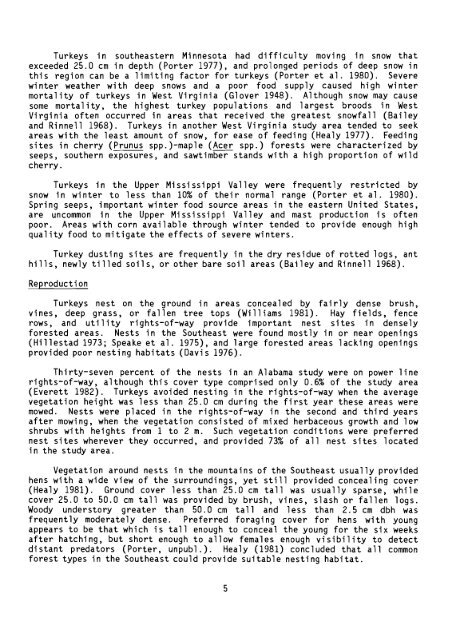habitat suitability index models: eastern wild turkey - USGS National ...
habitat suitability index models: eastern wild turkey - USGS National ...
habitat suitability index models: eastern wild turkey - USGS National ...
You also want an ePaper? Increase the reach of your titles
YUMPU automatically turns print PDFs into web optimized ePapers that Google loves.
Turkeys in south<strong>eastern</strong> Mi nnesota had di ffi cu1 ty movi ng in snow that<br />
exceeded 25.0 cm in depth (Porter 1977), and prolonged periods of deep snow in<br />
this region can be a limiting factor for <strong>turkey</strong>s (Porter et a1. 1980). Severe<br />
wi nter weather with deep snows and a poor food supply caused hi gh wi nter<br />
mortality of <strong>turkey</strong>s in West Virginia (Glover 1948). Although snow may cause<br />
some mortality, the highest <strong>turkey</strong> populations and largest broods in West<br />
Vi rgi ni a often occurred in areas that recei ved the greatest snowfall (Bail ey<br />
and Rinne11 1968). Turkeys in another West Virginia study area tended to seek<br />
areas with the least amount of snow, for ease of feeding (Healy 1977). Feeding<br />
sites in cherry (Prunus spp.)-map1e (Acer spp.) forests were characterized by<br />
seeps, southern exposures, and sawtimber stands with a high proportion of <strong>wild</strong><br />
cherry.<br />
Turkeys in the Upper Mississippi Valley were frequently restricted by<br />
snow in winter to less than 10% of their normal range (Porter et al. 1980).<br />
Spring seeps, important winter food source areas in the <strong>eastern</strong> United States,<br />
are uncommon in the Upper Mississippi Valley and mast production is often<br />
poor. Areas with corn available through winter tended to provide enough high<br />
quality food to mitigate the effects of severe winters.<br />
Turkey dusting sites are frequently in the dry residue of rotted logs, ant<br />
hills, newly tilled soils, or other bare soil areas (Bailey and Rinne11 1968).<br />
Reproduction<br />
Turkeys nest on the ground in areas concealed by fairly dense brush,<br />
vines, deep grass, or fallen tree tops (Williams 1981). Hay fields, fence<br />
rows, and utility rights-of-way provide important nest sites in densely<br />
forested areas. Nests in the Southeast were found mostly in or near openings<br />
(Hillestad 1973; Speake et a1. 1975), and large forested areas lacking openings<br />
provided poor nesting <strong>habitat</strong>s (Davis 1976).<br />
Thirty-seven percent of the nests in an Alabama study were on power line<br />
rights-of-way, although this cover type comprised only 0.6% of the study area<br />
(Everett 1982). Turkeys avoided nesting in the rights-of-way when the average<br />
vegetation height was less than 25.0 cm during the first year these areas were<br />
mowed. Nests were placed in the rights-of-way in the second and third years<br />
after mowing, when the vegetation consisted of mixed herbaceous growth and low<br />
shrubs with heights from 1 to 2 m. Such vegetation conditions were preferred<br />
nest sites wherever they occurred, and provided 73% of all nest sites located<br />
in the study area.<br />
Vegetation around nests in the mountains of the Southeast usually provided<br />
hens with a wide view of the surroundings, yet still provided concealing cover<br />
(Healy 1981). Ground cover less than 25.0 cm tall was usually sparse, while<br />
cover 25.0 to 50.0 cm tall was provided by brush, vines, slash or fallen logs.<br />
Woody understory greater than 50.0 cm tall and 1ess than 2.5 cm dbh was<br />
frequently moderately dense. Preferred foraging cover for hens with young<br />
appears to be that which is tall enough to conceal the young for the six weeks<br />
after hatching, but short enough to allow females enough visibility to detect<br />
distant predators (Porter, unpubl.). Healy (1981) concluded that all common<br />
forest types in the Southeast could provide suitable nesting <strong>habitat</strong>.<br />
5

















